Measuring Environmental Justice in Real Time: A Pilot Study Using Digital Participatory Method in the Global South, Nepal
Abstract
:1. Introduction
2. Materials and Methods
2.1. Study Context
2.2. Digital Participatory Method Using Ecological Momentary Assessment
2.3. Smartphone-Based EMA App and Questionnaires
2.4. Study Population: Piloting, Recruiting and Training
2.5. Ethical Consideration
2.6. Data Cleaning and Statistical Analysis
3. Results
3.1. Characteristics of Participants (N = 22)
3.2. Adherence to the Study Approach
3.3. Perceived Environmental Exposures by Type and Sources
3.4. Subjective Concerns and Subjective Perceptions towards Fairness of Exposures across Environmental Types
3.5. Subjective Perceptions on Controllability across Various Types of Exposures
3.6. Momentary Mood, Life Satisfaction and Subjective Health Status
3.7. Subjective Perception before and after the Study (N = 22)
3.8. Qualitative Remarks on the Study and Application
“…during and after the participation, I become more conscious about the environmental hazard nearby.” (ID 4)
“..I felt a difference in the way I used to look at the things around.” (ID29)
“citizens can directly report about the different pollutions and built environmental issues …so that municipality can easily solve the problem.” (ID24)
“..I feel motivated to do something about the pollution eventhough it makes a small difference.” (ID7)
4. Discussion
4.1. Key Findings
4.2. Methodological and Practical Considerations
4.2.1. Technology Related Challenges and Needs
4.2.2. Participants Involvement, Retention, Study Duration and Coping with Uncertainties
4.2.3. Digitally Enabled Participatory Method for Environmental Justice
4.3. Strengths and Limitations
5. Conclusions
Supplementary Materials
Author Contributions
Funding
Institutional Review Board Statement
Informed Consent Statement
Data Availability Statement
Acknowledgments
Conflicts of Interest
References
- Prüss-Üstün, A.; Corvalán, C.F. Preventing Disease through Healthy Environments: Towards an Estimate of the Environmental Burden of Disease; World Health Organization: Geneva, Switzerland, 2006. [Google Scholar]
- Prüss-Üstün, A.; Wolf, J.; Corvalan, C.; Neville, T.; Bos, R.; Neira, M. Diseases due to unhealthy environments: An updated estimate of the global burden of disease attributable to environmental determinants of health. J. Public Health 2017, 39, 464–475. [Google Scholar] [CrossRef] [PubMed]
- Confraria, H.; Godinho, M.M.; Wang, L. Determinants of citation impact: A comparative analysis of the Global South versus the Global North. Res. Policy 2017, 46, 265–279. [Google Scholar] [CrossRef] [Green Version]
- Alvarez, C.H.; Evans, C.R. Intersectional environmental justice and population health inequalities: A novel approach. Soc. Sci. Med. 2020, 269, 113559. [Google Scholar] [CrossRef] [PubMed]
- Hajat, A.; Hsia, C.; O’Neill, M.S. Socioeconomic disparities and air pollution exposure: A global review. Curr. Environ. Health Rep. 2015, 2, 440–450. [Google Scholar] [CrossRef] [PubMed] [Green Version]
- Shao, S.; Liu, L.; Tian, Z. Does the environmental inequality matter? A literature review. Environ. Geochem. Health 2021. [Google Scholar] [CrossRef]
- Xie, X.; Semanjski, I.; Gautama, S.; Tsiligianni, E.; Deligiannis, N.; Rajan, R.T.; Pasveer, F.; Philips, W. A review of urban air pollution monitoring and exposure assessment method. ISPRS Int. J. Geo-Inf. 2017, 6, 389. [Google Scholar] [CrossRef] [Green Version]
- Ma, J.; Mitchell, G.; Dong, G.; Zhang, W. Inequality in Beijing: A spatial multilevel analysis of perceived environmental hazard and self-rated health. Ann. Am. Assoc. Geogr. 2017, 107, 109–129. [Google Scholar] [CrossRef] [Green Version]
- Schuppert, F.; Wallimann-Helmer, I. Environmental inequalities and democratic citizenship: Linking normative theory with empirical research. Anal. Krit. 2014, 36, 345–366. [Google Scholar] [CrossRef] [Green Version]
- Lucas, T.; Alexander, S.; Firestone, I.; Lebreton, J.M. Just world beliefs, perceived stress, and health behavior: The impact of a procedurally just world. Psychol. Health 2008, 23, 849–865. [Google Scholar] [CrossRef]
- Jensen, E.; Dehlin, O.; Hagberg, B.; Samuelsson, G.; Svensson, T. Insomnia in an 80-year-old population: Relationship to medical, psychological and social factors. J. Sleep Res. 1998, 7, 183–189. [Google Scholar] [CrossRef]
- Dzuka, J.; Dalbert, C. Student violence against teachers: Teachers’ well-being and the belief in a just world. Eur. Psychol. 2007, 12, 253–260. [Google Scholar] [CrossRef]
- Dalbert, C. Belief in a just world, well-being, and coping with an unjust fate. In Responses to Victimizations and Belief in a Just World; Springer: Berlin/Heidelberg, Germany, 1998; pp. 87–105. [Google Scholar]
- Xie, X.; Liu, H.; Gan, Y. Belief in a just world when encountering the 5/12 Wenchuan earthquake. Environ. Behav. 2011, 43, 566–586. [Google Scholar]
- Jiang, F.; Yue, X.; Lu, S.; Yu, G.; Zhu, F. How Belief in a Just World Benefits Mental Health: The Effects of Optimism and Gratitude. Soc. Indic. Res. 2016, 126, 411–423. [Google Scholar] [CrossRef]
- Caplin, A.; Ghandehari, M.; Lim, C.; Glimcher, P.; Thurston, G. Advancing environmental exposure assessment science to benefit society. Nat. Commun. 2019, 10, 1236. [Google Scholar] [CrossRef] [Green Version]
- Nemati, E.; Batteate, C.; Jerrett, M. Opportunistic environmental sensing with smartphones: A critical review of current literature and applications. Curr. Environ. Health Rep. 2017, 4, 306–318. [Google Scholar] [CrossRef] [PubMed]
- Maisonneuve, N.; Stevens, M.; Ochab, B. Participatory noise pollution monitoring using mobile phones. Inf. Polity 2010, 15, 51–71. [Google Scholar] [CrossRef] [Green Version]
- Liu, H.; Chen, Y.; Ma, L. Effect of time-varying exposure to air pollution on subjective well-being. J. Clean. Prod. 2021, 281, 125364. [Google Scholar] [CrossRef]
- Shiffman, S.; Stone, A.A.; Hufford, M.R. Ecological momentary assessment. Annu. Rev. Clin. Psychol. 2008, 4, 1–32. [Google Scholar] [CrossRef]
- Bhattarai, K.; Conway, D. Contemporary Environmental Problems in Nepal: Geographic Perspectives; Springer Nature: Berlin/Heidelberg, Germany, 2020. [Google Scholar]
- Pathak, K.P.; Gaire, T. Nepal: Country report on children’s environmental health. Rev. Environ. Health 2020, 35, 53–56. [Google Scholar] [CrossRef]
- Karki, K.B.; Dhakal, P.; Shrestha, S.L.; Joshi, H.D.; Aryal, K.K.; Poudyal, A.; Puri, S.; Verma, S.C.; Pokhrel, A.; Lohani, G.R. Situation Analysis of Ambient Air Pollution and Respiratory Health Effects in Kathmandu Valley; Nepal Health Research Council: Kathmandu, Nepal, 2016. [Google Scholar]
- Gurung, A. Understanding Air Pollution and Human Health Burden Associated in Kathmandu Valley, Nepal; Yale University: New Haven, CT, USA, 2016. [Google Scholar]
- Saud, B.; Paudel, G. The Threat of Ambient Air Pollution in Kathmandu, Nepal. J. Environ. Public Health 2018, 2018, 1504591. [Google Scholar] [CrossRef] [Green Version]
- Chauhan, R.; Shrestha, A.; Khanal, D. Noise pollution and effectiveness of policy interventions for its control in Kathmandu, Nepal. Environ. Sci. Pollut. Res. 2021, 28, 35678–35689. [Google Scholar] [CrossRef] [PubMed]
- Giri, D.; Murthy, K.; Adhikary, P.; Khanal, S. Ambient air quality of Kathmandu valley as reflected by atmospheric particulate matter concentrations (PM 10). Int. J. Environ. Sci. Technol. 2006, 3, 403–410. [Google Scholar] [CrossRef] [Green Version]
- Murthy, V.K.; Majumder, A.K.; Khanal, S.N.; Subedi, D.P. Assessment of traffic noise pollution in Banepa, a semi urban town of Nepal. Kathmandu Univ. J. Sci. Eng. Technol. 2007, 3, 12–20. [Google Scholar] [CrossRef] [Green Version]
- Shiffman, S.; Stone, A.A. Introduction to the special section: Ecological momentary assessment in health psychology. Health Psychol. 1998, 17, 3. [Google Scholar] [CrossRef]
- Oreel, T.H.; Delespaul, P.; Hartog, I.D.; Henriques, J.P.; Netjes, J.E.; Vonk, A.B.; Lemkes, J.; Scherer-Rath, M.; van Laarhoven, H.W.; Sprangers, M.A. Ecological momentary assessment versus retrospective assessment for measuring change in health-related quality of life following cardiac intervention. J. Patient-Rep. Outcomes 2020, 4, 98. [Google Scholar] [CrossRef] [PubMed]
- Bruening, M.; Ohri-Vachaspati, P.; Brewis, A.; Laska, M.; Todd, M.; Hruschka, D.; Schaefer, D.R.; Whisner, C.M.; Dunton, G. Longitudinal social networks impacts on weight and weight-related behaviors assessed using mobile-based ecological momentary assessments: Study Protocols for the SPARC study. BMC Public Health 2016, 16, 901. [Google Scholar] [CrossRef] [PubMed] [Green Version]
- Mennis, J.; Mason, M.; Ambrus, A. Urban greenspace is associated with reduced psychological stress among adolescents: A Geographic Ecological Momentary Assessment (GEMA) analysis of activity space. Landsc. Urban Plan. 2018, 174, 1–9. [Google Scholar] [CrossRef]
- Kou, L.; Tao, Y.; Kwan, M.-P.; Chai, Y. Understanding the relationships among individual-based momentary measured noise, perceived noise, and psychological stress: A geographic ecological momentary assessment (GEMA) approach. Health Place 2020, 64, 102285. [Google Scholar] [CrossRef]
- Wang, J.; Kou, L.; Kwan, M.-P.; Shakespeare, R.M.; Lee, K.; Park, Y.M. An Integrated Individual Environmental Exposure Assessment System for Real-Time Mobile Sensing in Environmental Health Studies. Sensors 2021, 21, 4039. [Google Scholar] [CrossRef]
- Wheeler, L.; Reis, H.T. Self-recording of everyday life events: Origins, types, and uses. J. Personal. 1991, 59, 339–354. [Google Scholar] [CrossRef]
- Soyster, P.D.; Fisher, A.J. Involving stakeholders in the design of ecological momentary assessment research: An example from smoking cessation. PLoS ONE 2019, 14, e0217150. [Google Scholar] [CrossRef] [PubMed] [Green Version]
- Movisensxs. Available online: https://www.movisens.com/en/products/movisensxs/ (accessed on 1 January 2021).
- Bruderer Enzler, H.; Diekmann, A.; Hartmann, J.; Herold, L.; Kilburger, K.; Kurz, K.; Liebe, U.; Preisendörfer, P. Umweltgerechtigkeit—Soziale Verteilungsmuster, Gerechtigkeits- einschätzungen und Akzeptanzschwellen. Available online: https://data.gesis.org/sharing/#!Detail/10.7802/1993 (accessed on 11 April 2022).
- Bullers, S. Environmental stressors, perceived control, and health: The case of residents near large-scale hog farms in eastern North Carolina. Hum. Ecol. 2005, 33, 1–16. [Google Scholar] [CrossRef]
- Bolte, G.; Schönbach, J.; Schüz, B. DASEIN: Digital assessment of subjective environmental exposure and environmental injustice. Available online: https://www.ipp.uni-bremen.de/departments/social-epidemiology/projects/en/?proj=802 (accessed on 14 February 2022).
- Burke, L.E.; Shiffman, S.; Music, E.; Styn, M.A.; Kriska, A.; Smailagic, A.; Siewiorek, D.; Ewing, L.J.; Chasens, E.; French, B. Ecological momentary assessment in behavioral research: Addressing technological and human participant challenges. J. Med. Internet Res. 2017, 19, e77. [Google Scholar] [CrossRef] [PubMed]
- Schleicher, M.; Unnikrishnan, V.; Neff, P.; Simoes, J.; Probst, T.; Pryss, R.; Schlee, W.; Spiliopoulou, M. Understanding adherence to the recording of ecological momentary assessments in the example of tinnitus monitoring. Sci. Rep. 2020, 10, 22459. [Google Scholar] [CrossRef]
- Bates, D.; Mächler, M.; Bolker, B.; Walker, S. Lme4: Linear mixed-effects models using Eigen and S4. R package version 1.1–7. J. Stat. Softw. 2014, 67. [Google Scholar]
- Koprowska, K.; Łaszkiewicz, E.; Kronenberg, J.; Marcińczak, S. Subjective perception of noise exposure in relation to urban green space availability. Urban For. Urban Green. 2018, 31, 93–102. [Google Scholar] [CrossRef]
- Choi, E.; Bhandari, T.R.; Shrestha, N. Social inequality, noise pollution, and quality of life of slum dwellers in Pokhara, Nepal. Arch. Environ. Occup. Health 2020, 77, 149–160. [Google Scholar] [CrossRef]
- Ma, J.; Tao, Y.; Kwan, M.-P.; Chai, Y. Assessing Mobility-Based Real-Time Air Pollution Exposure in Space and Time Using Smart Sensors and GPS Trajectories in Beijing. Ann. Am. Assoc. Geogr. 2020, 110, 434–448. [Google Scholar] [CrossRef]
- Dias, D.; Tchepel, O. Spatial and Temporal Dynamics in Air Pollution Exposure Assessment. Int. J. Environ. Res. Public Health 2018, 15, 558. [Google Scholar] [CrossRef] [Green Version]
- Berkers, E.; Pop, I.; Cloïn, M.; Eugster, A.; van Oers, H. The relative effects of self-reported noise and odour annoyance on psychological distress: Different effects across sociodemographic groups? PLoS ONE 2021, 16, e0258102. [Google Scholar] [CrossRef]
- Maris, E.; Stallen, P.J.; Vermunt, R.; Steensma, H. Evaluating noise in social context: The effect of procedural unfairness on noise annoyance judgments. J. Acoust. Soc. Am. 2007, 122, 3483–3494. [Google Scholar] [CrossRef] [PubMed]
- Nepal Telecommunications Authority. Management Information Service Report, MIS Reports; Nepal Telecommunications Authority: Kathmandu, Nepal, 2015. [Google Scholar]
- Poushter, J. Smartphone ownership and internet usage continues to climb in emerging economies. Pew Res. Cent. 2016, 22, 1–44. [Google Scholar]
- Kaur, E.; Haghighi, P.D.; Burstein, F.; Urquhart, D.; Cicuttini, F. Challenges and opportunities of mobile data collection in clinical studies. In Proceedings of the 18th International Conference on Advances in Mobile Computing & Multimedia, Chiang Mai, Thailand, 30 November–2 December 2020; pp. 129–137. [Google Scholar]
- Yang, Y.S.; Ryu, G.W.; Choi, M. Methodological Strategies for Ecological Momentary Assessment to Evaluate Mood and Stress in Adult Patients Using Mobile Phones: Systematic Review. JMIR Mhealth Uhealth 2019, 7, e11215. [Google Scholar] [CrossRef] [PubMed]
- Huh, J.; Cerrada, C.J.; Kirkpatrick, M.G.; Dunton, G.; Leventhal, A.M. Social contexts of momentary craving to smoke among Korean American emerging adults. Addict. Behav. 2016, 56, 23–29. [Google Scholar] [CrossRef] [PubMed]
- Stefano, E.C.; Hudson, D.L.; Whisenhunt, B.L.; Buchanan, E.M.; Latner, J.D. Examination of body checking, body image dissatisfaction, and negative affect using ecological momentary assessment. Eat. Behav. 2016, 22, 51–54. [Google Scholar] [CrossRef]
- Inada, S.; Yoshiuchi, K.; Iizuka, Y.; Ohashi, K.; Kikuchi, H.; Yamamoto, Y.; Kadowaki, T.; Akabayashi, A. Pilot Study for the Development of a Self-Care System for Type 2 Diabetes Patients Using a Personal Digital Assistant (PDA). Int. J. Behav. Med. 2016, 23, 295–299. [Google Scholar] [CrossRef]
- Wrzus, C.; Neubauer, A.B. Ecological Momentary Assessment: A Meta-Analysis on Designs, Samples, and Compliance across Research Fields. Assessment 2022, 1–22. [Google Scholar] [CrossRef]
- Riedel, N.; Scheiner, J.; Müller, G.; Köckler, H. Assessing the relationship between objective and subjective indicators of residential exposure to road traffic noise in the context of environmental justice. J. Environ. Plan. Manag. 2014, 57, 1398–1421. [Google Scholar] [CrossRef]
- Martuzzi, M.; Mitis, F.; Forastiere, F. Inequalities, inequities, environmental justice in waste management and health. Eur. J. Public Health 2010, 20, 21–26. [Google Scholar] [CrossRef]
- Verbeek, T. Unequal residential exposure to air pollution and noise: A geospatial environmental justice analysis for Ghent, Belgium. SSM-Popul. Health 2019, 7, 100340. [Google Scholar] [CrossRef]
- Park, Y.M.; Kwan, M.-P. Multi-Contextual Segregation and Environmental Justice Research: Toward Fine-Scale Spatiotemporal Approaches. Int. J. Environ. Res. Public Health 2017, 14, 1205. [Google Scholar] [CrossRef] [PubMed] [Green Version]
- Kwan, M.-P. The Limits of the Neighborhood Effect: Contextual Uncertainties in Geographic, Environmental Health, and Social Science Research. Ann. Am. Assoc. Geogr. 2018, 108, 1482–1490. [Google Scholar] [CrossRef]
- Kwan, M.-P. The Uncertain Geographic Context Problem. Ann. Assoc. Am. Geogr. 2012, 102, 958–968. [Google Scholar] [CrossRef]
- Kwan, M.-P. How GIS can help address the uncertain geographic context problem in social science research. Ann. GIS 2012, 18, 245–255. [Google Scholar] [CrossRef]
- Dzhambov, A.M.; Markevych, I.; Tilov, B.; Arabadzhiev, Z.; Stoyanov, D.; Gatseva, P.; Dimitrova, D.D. Pathways linking residential noise and air pollution to mental ill-health in young adults. Environ. Res. 2018, 166, 458–465. [Google Scholar] [CrossRef]
- McCrea, R.; Shyy, T.-K.; Stimson, R. What is the Strength of the Link between Objective and Subjective Indicators of Urban Quality of Life? Appl. Res. Qual. Life 2006, 1, 79–96. [Google Scholar] [CrossRef]
- Chiarini, B.; D’Agostino, A.; Marzano, E.; Regoli, A. Air quality in urban areas: Comparing objective and subjective indicators in European countries. Ecol. Indic. 2021, 121, 107144. [Google Scholar] [CrossRef]
- Chiarini, B.; D’Agostino, A.; Marzano, E.; Regoli, A. The perception of air pollution and noise in urban environments: A subjective indicator across European countries. J. Environ. Manag. 2020, 263, 110272. [Google Scholar] [CrossRef]
- Bales, E.; Nikzad, N.; Quick, N.; Ziftci, C.; Patrick, K.; Griswold, W.G. Personal pollution monitoring: Mobile real-time air quality in daily life. Pers. Ubiquitous Comput. 2019, 23, 309–328. [Google Scholar] [CrossRef]
- Park, E.-A.; Lee, S. Multidimensionality: Redefining the digital divide in the smartphone era. Info 2015, 17, 80–96. [Google Scholar] [CrossRef]
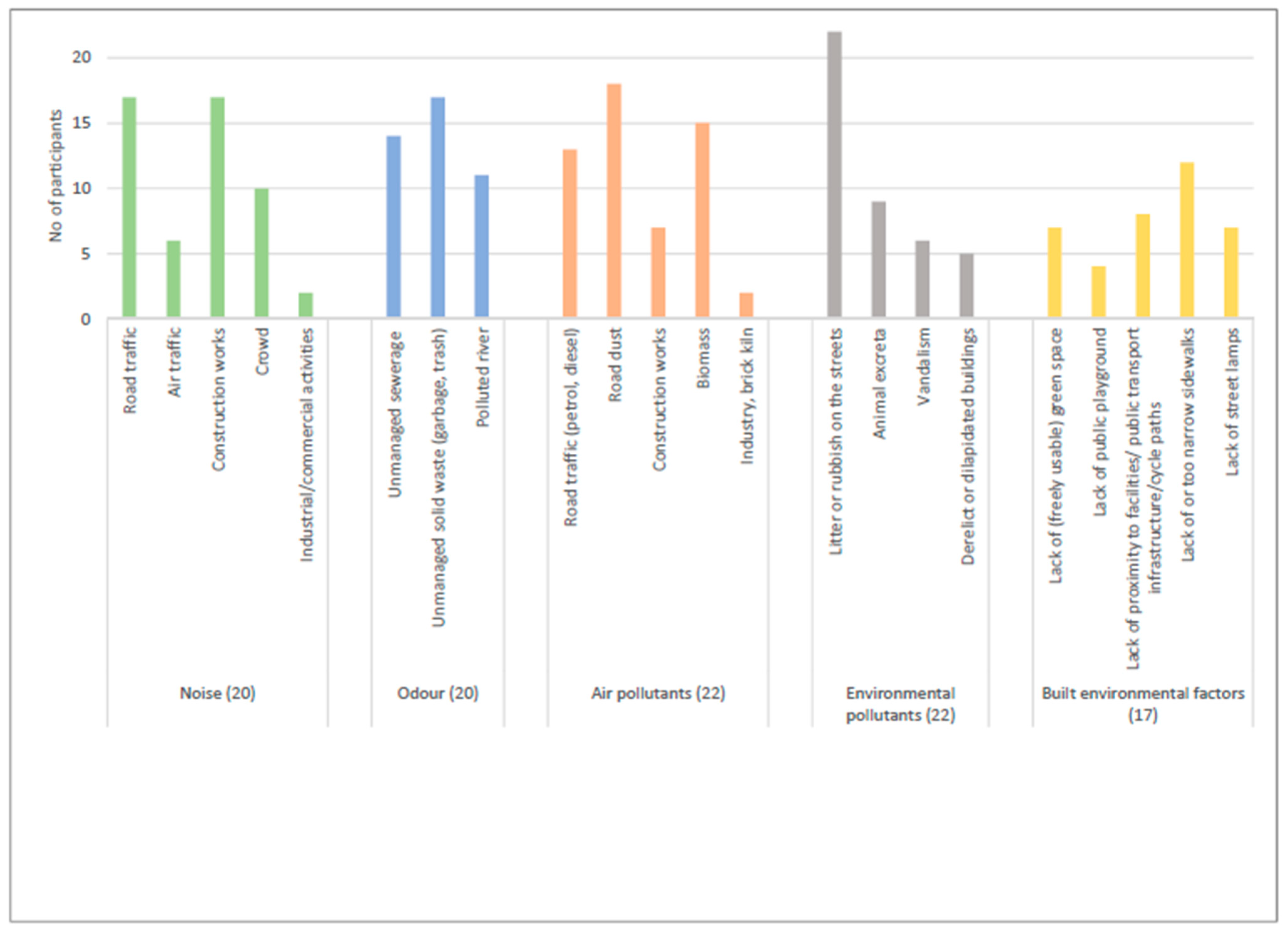
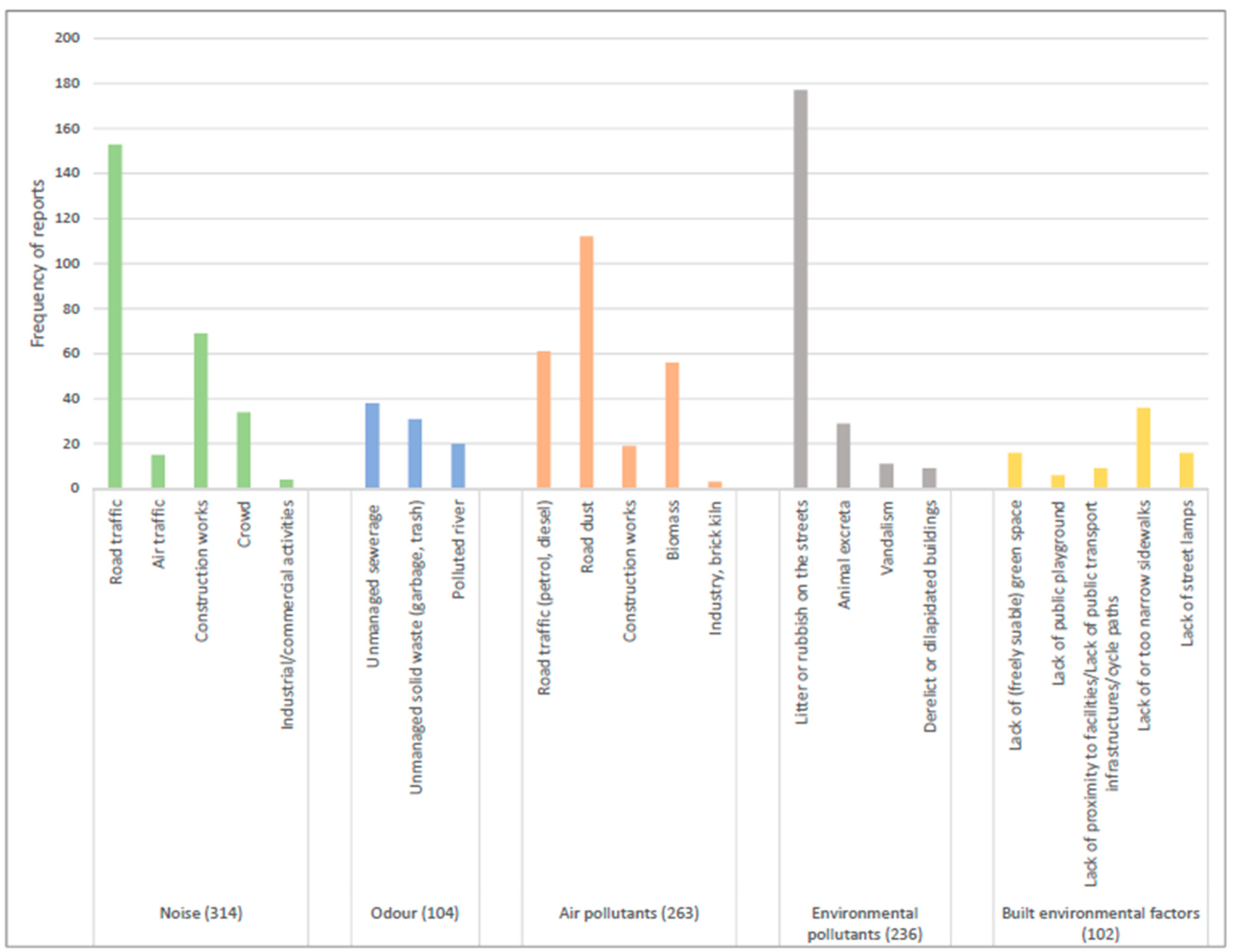
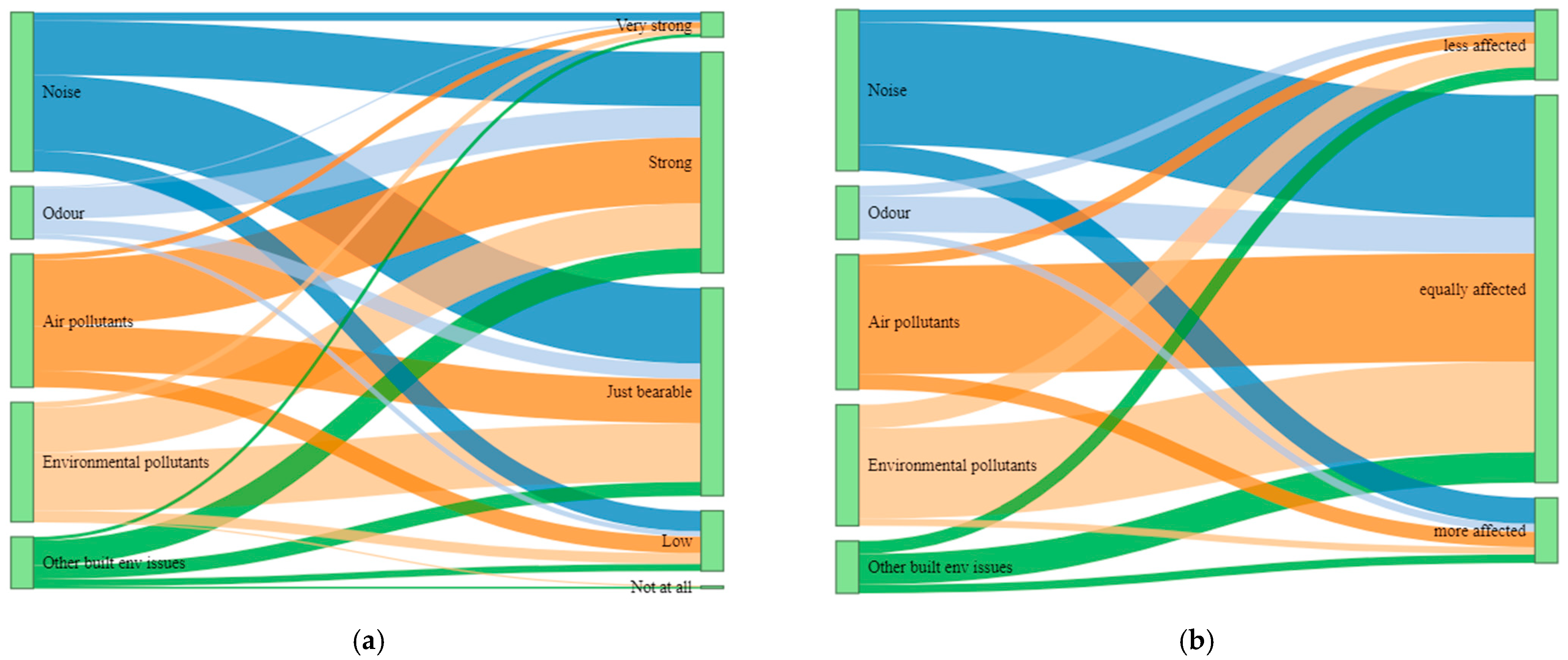
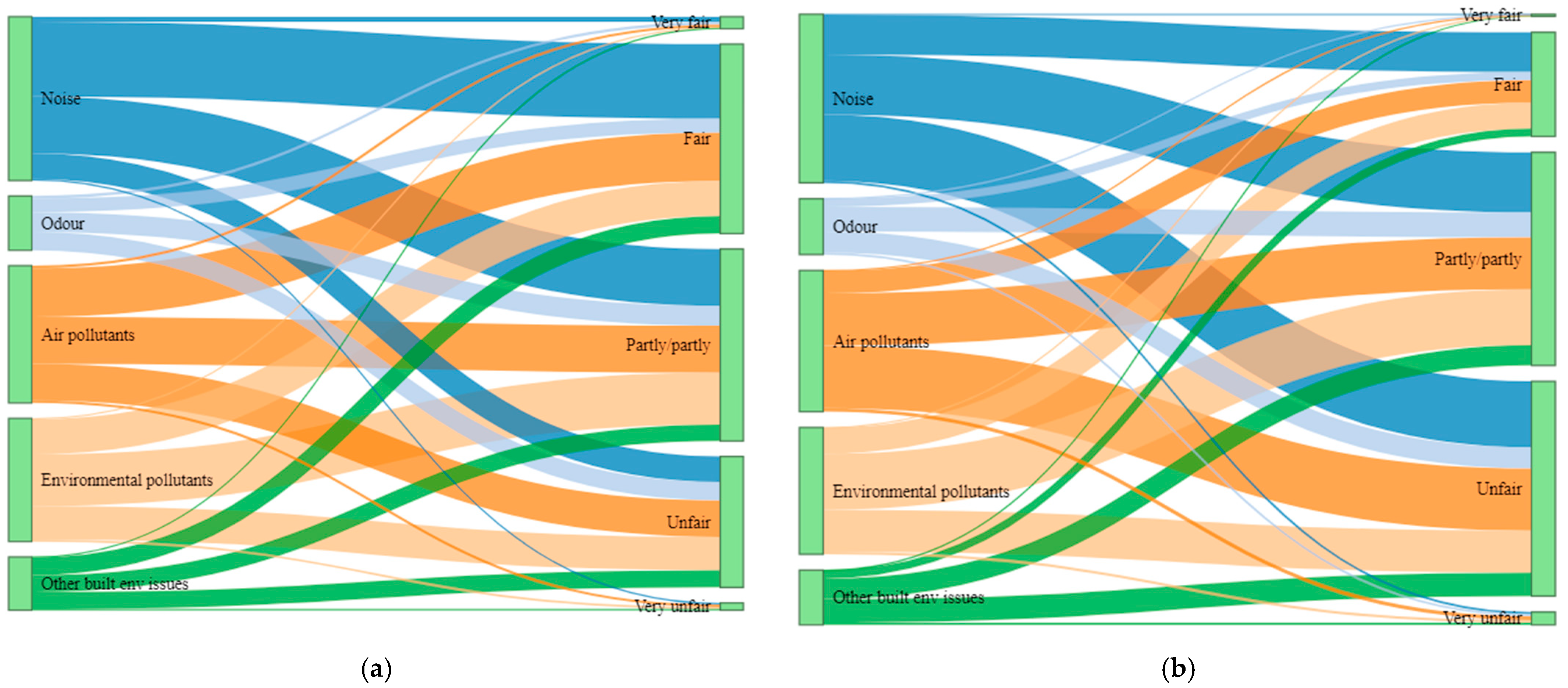
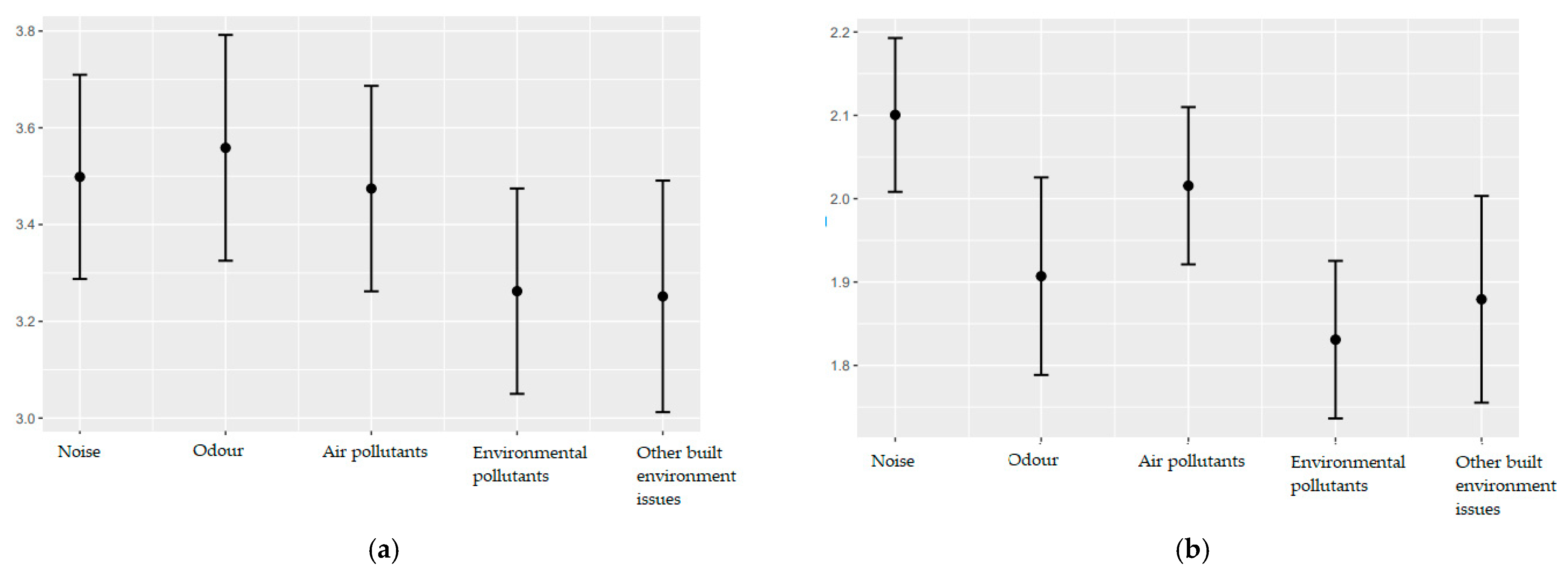
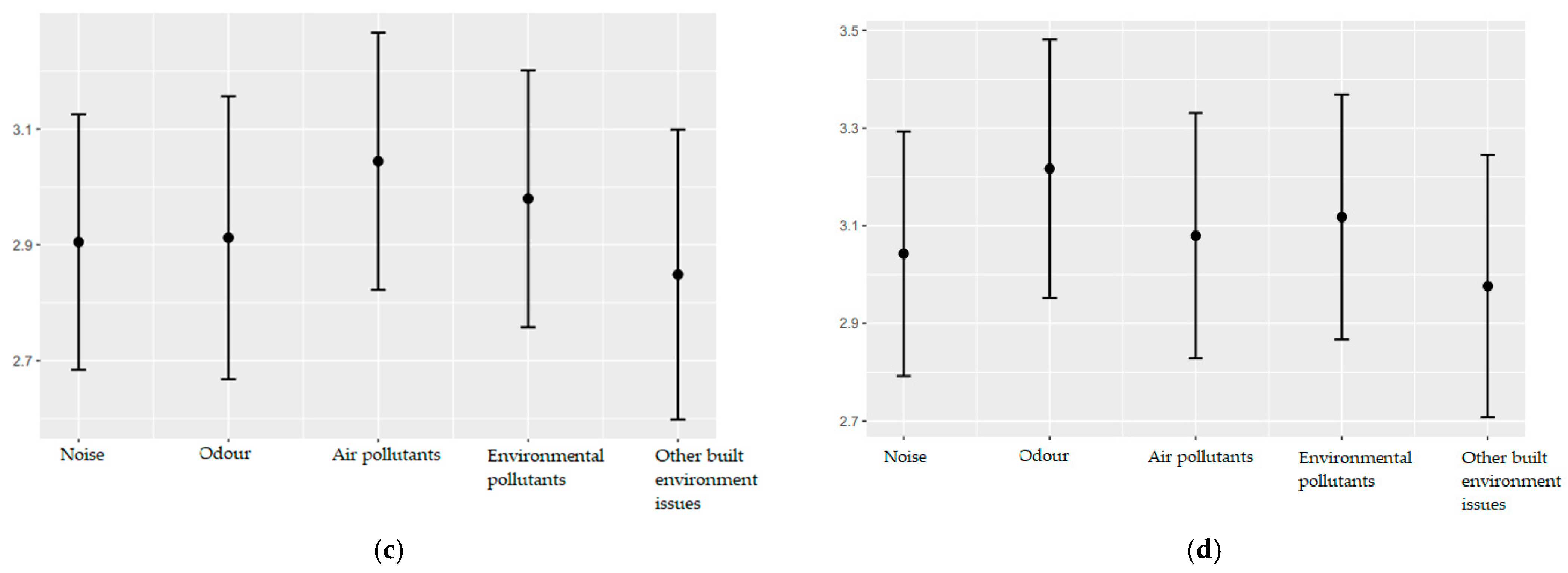
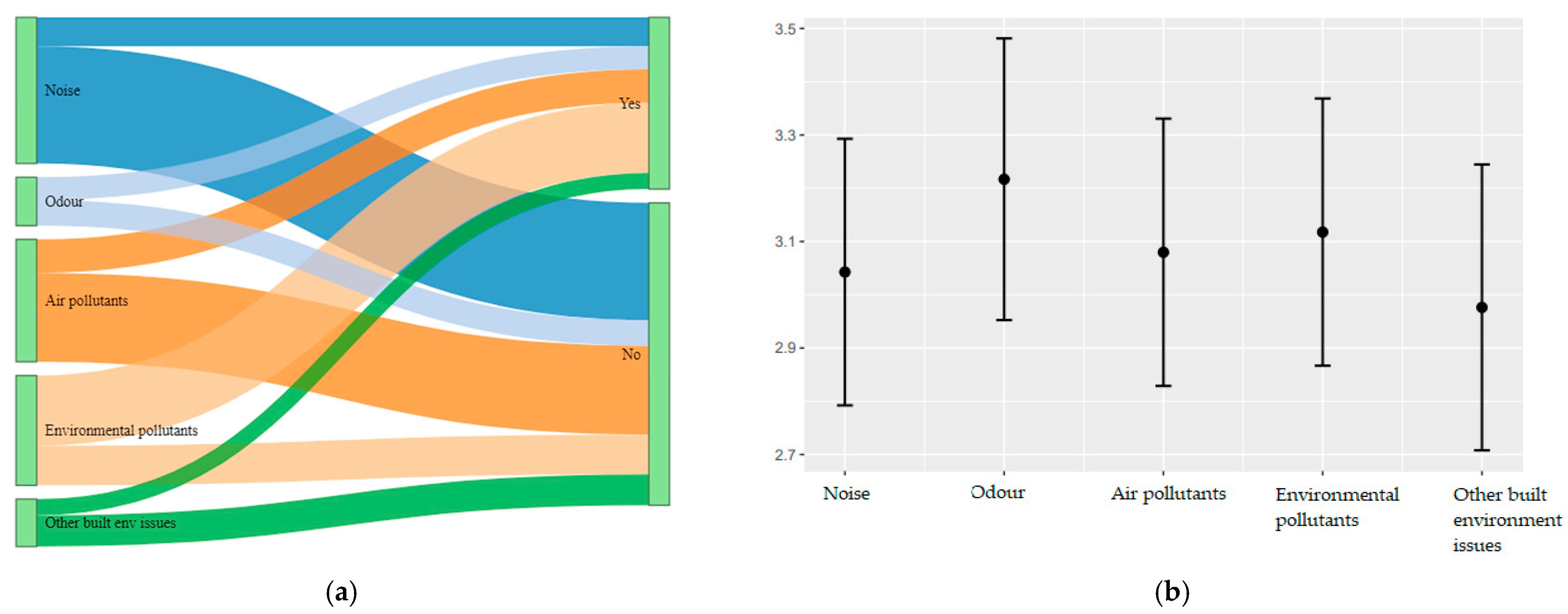
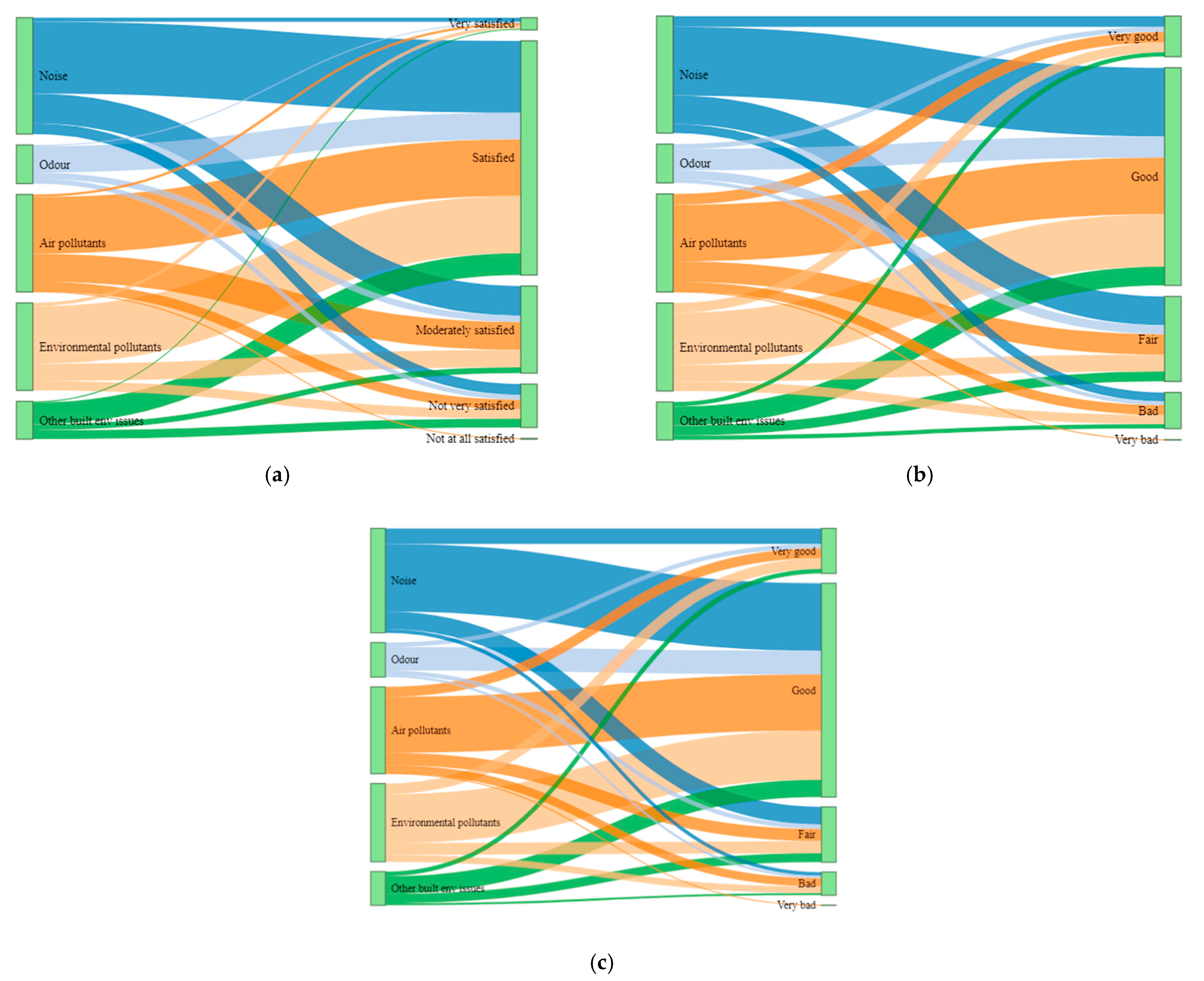
| Characteristics | Sub-Categories | n | % |
|---|---|---|---|
| Gender | Male | 13 | 59 |
| Female | 9 | 41 | |
| Education | Bachelor’s education (ongoing) | 17 | 77 |
| Master’s education (ongoing) | 5 | 23 | |
| Academic discipline | Health | 10 | 45 |
| Engineering | 12 | 55 | |
| Current place of living | Urban Municipality | 21 | 95 |
| Rural Municipality | 1 | 5 | |
| Household income | Low | 4 | 18 |
| Medium | 13 | 59 | |
| High | 5 | 23 |
| Prompt Type | Abandoned a (n = 1040) | Missed b (n = 616) | Mismatched c | Location Submitted (Only for C = Current Exposure) | Images Submitted (Only for C = Current Exposure) | Total |
|---|---|---|---|---|---|---|
| Event contingent (self-assessments) | 21 (2.0%) | N/A | 39 (3.8%) | 793 (94.9%) | 625 (74.8%) | 1040 (including abandoned), |
| 1019 (excluding abandoned), | ||||||
| (C = 836, P = 183) | ||||||
| Time-contingent (control question) | N/A | 53 (9.0%) | N/A | N/A | N/A | 616 |
| Prompt Type | Subcategory | Mean | Median | SD | Range |
|---|---|---|---|---|---|
| Event contingent (self-assessment) | Days of interaction a | 19.8 | 22 | 6.49 | 2–28 |
| Interaction continuity b | 5.7 | 5 | 5.7 | 1–28 | |
| Self-assessment | 46.3 | 41.5 | 35.12 | 2–174 | |
| Abandoned c | 2% | 0% | 3% | 0–9% | |
| Mismatched d | 1.8 | 1.0 | 2.2 | 0–9 | |
| Location submits | 93% | 99% | 13% | 46–100% | |
| Image submits | 74% | 80% | 29% | 0–100% | |
| Time contingent (control question) | Missed e | 2.4 | 1.5 | 2.8 | 0–11 |
| Dependent Variable | Intraclass Correlation Coefficients and 95% Confidence Intervals |
|---|---|
| Perceived effects due to exposures | 0.327 [0.177, 0.462] |
| Perceived effects as compared to others | 0.100 [0.038, 0.173] |
| Perceived fairness of exposures as compared to others | 0.325 [0.175, 0.450] |
| Perceived fairness of distribution of exposures in respective municipality | 0.505 [0.324, 0.637] |
| Dependent Variable | Intraclass Correlation Coefficients and 95% Confidence Intervals |
|---|---|
| Momentary perceived life satisfaction | 0.614 [0.430, 0.734] |
| Momentary perceived mood | 0.530 [0.345, 0.667] |
| Momentary perceived health status | 0.663 [0.484, 0.775] |
| Environmental Factors | Diff of Mean | Sig. Test | Environmental Factors | Diff of Mean | Sig. Test |
|---|---|---|---|---|---|
| Noise | Environmental pollutants | ||||
| −0.71 | 0.016 |
| −0.23 | 0.387 |
| −0.73 | 0.003 |
| 0 | 0.903 |
| −0.50 | 0.017 |
| −0.27 | 0.243 |
| −0.19 | 0.430 |
| −0.48 | 0.117 |
| Odour |
| −0.32 | 0.323 | ||
| −0.55 | 0.062 | Built env. Factors (lack of) | ||
| −0.82 | 0.006 |
| −0.23 | 0.396 |
| −0.52 | 0.029 |
| −0.36 | 0.131 |
| Air pollution |
| 0.14 | 0.536 | ||
| −0.52 | 0.074 |
| −0.27 | 0.355 |
| −0.14 | 0.650 |
| 0.14 | 0.496 |
| −0.05 | 0.941 |
| 0 | 0.948 |
| −0.50 | 0.137 |
| 0.27 | 0.392 |
| −0.36 | 0.12 |
Publisher’s Note: MDPI stays neutral with regard to jurisdictional claims in published maps and institutional affiliations. |
© 2022 by the authors. Licensee MDPI, Basel, Switzerland. This article is an open access article distributed under the terms and conditions of the Creative Commons Attribution (CC BY) license (https://creativecommons.org/licenses/by/4.0/).
Share and Cite
Shrestha, R.; Telkmann, K.; Schüz, B.; Koju, P.; Shrestha, R.; Karmacharya, B.; Bolte, G. Measuring Environmental Justice in Real Time: A Pilot Study Using Digital Participatory Method in the Global South, Nepal. Int. J. Environ. Res. Public Health 2022, 19, 4752. https://doi.org/10.3390/ijerph19084752
Shrestha R, Telkmann K, Schüz B, Koju P, Shrestha R, Karmacharya B, Bolte G. Measuring Environmental Justice in Real Time: A Pilot Study Using Digital Participatory Method in the Global South, Nepal. International Journal of Environmental Research and Public Health. 2022; 19(8):4752. https://doi.org/10.3390/ijerph19084752
Chicago/Turabian StyleShrestha, Rehana, Klaus Telkmann, Benjamin Schüz, Pramesh Koju, Reshma Shrestha, Biraj Karmacharya, and Gabriele Bolte. 2022. "Measuring Environmental Justice in Real Time: A Pilot Study Using Digital Participatory Method in the Global South, Nepal" International Journal of Environmental Research and Public Health 19, no. 8: 4752. https://doi.org/10.3390/ijerph19084752
APA StyleShrestha, R., Telkmann, K., Schüz, B., Koju, P., Shrestha, R., Karmacharya, B., & Bolte, G. (2022). Measuring Environmental Justice in Real Time: A Pilot Study Using Digital Participatory Method in the Global South, Nepal. International Journal of Environmental Research and Public Health, 19(8), 4752. https://doi.org/10.3390/ijerph19084752






